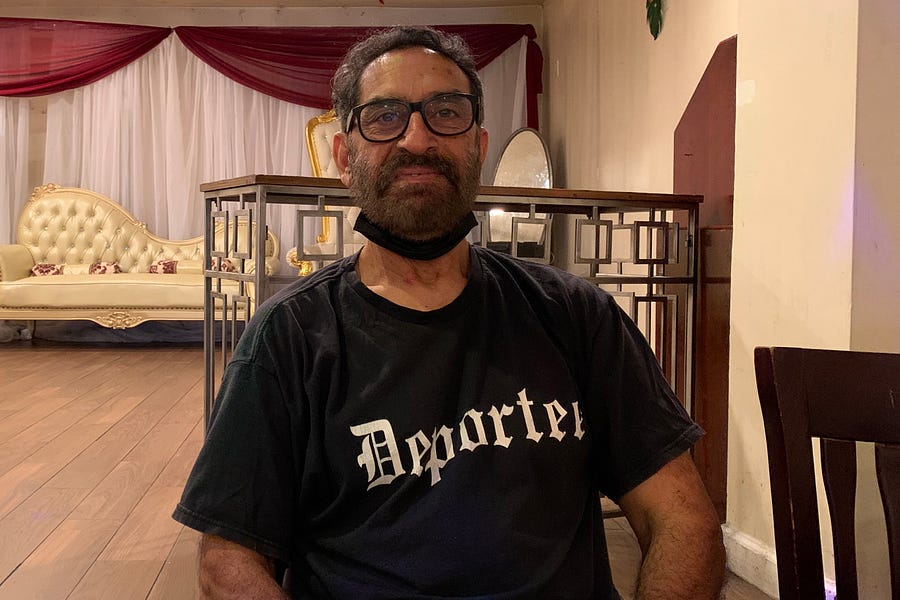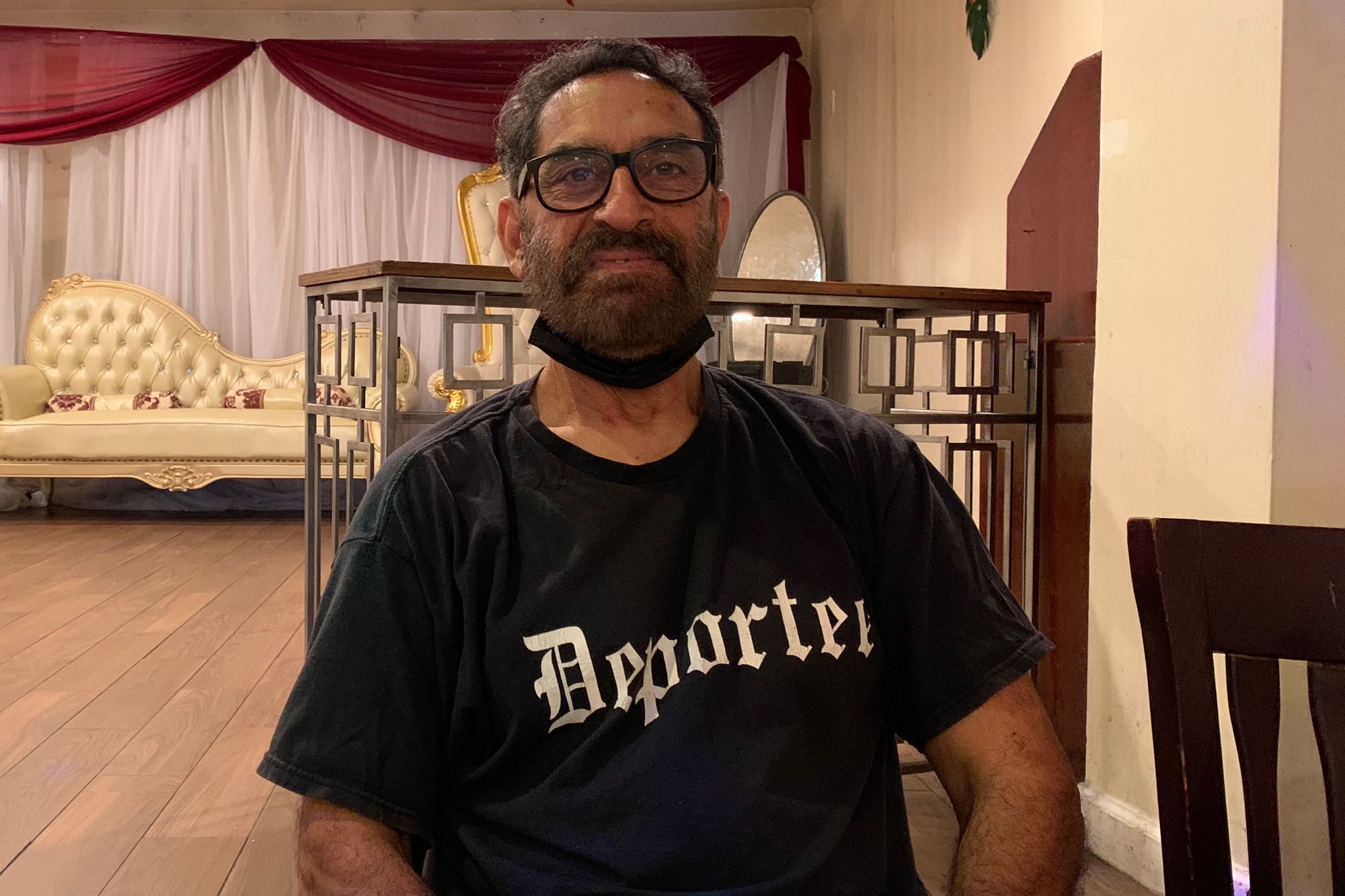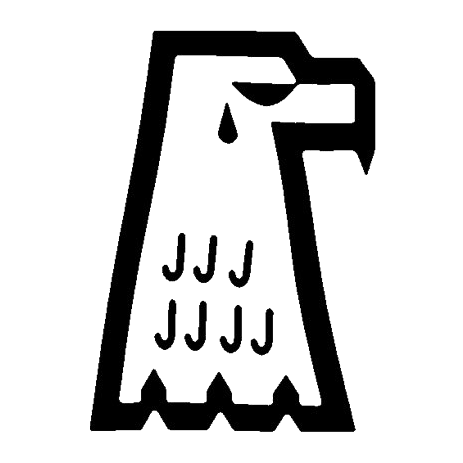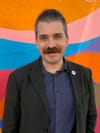Return To Little Pakistan: Bobby Khan v. The Police
An immigrant born to working-class activism stands up to an NYPD reborn in the CIA's image. Part 2 in a series


Edited by Sam Thielman
SIX YOUNG MEN in their late teens and early twenties stopped eating and stood up when Bobby Khan passed their booth in a restaurant on Coney Island Avenue late on a July morning. I don’t speak their language, but the daps and the grins they offered to the nearly 64-year old Khan said enough.
Khan is a soft-spoken man whose glasses take up much of his face. Yet he fought tenaciously for Little Pakistan—and Jackson Heights, Astoria, Bay Ridge and everywhere else comprising Muslim New York—when the post-9/11 roundups began. He channeled and embodied defiance for neighbors too intimidated to speak. When he entered the restaurant that day, he wore a t-shirt with DEPORTEE printed on the chest.
Khan and his Coney Island Avenue Project spent lonely days outside the Metropolitan Detention Center in Sunset Park after 9/11, demanding the release of the frightened people threatened by the feds with deportation if they wouldn’t turn informant. During a deposition in a civil-rights lawsuit, when he was asked what he thought of a movie that insulted the Prophet Muhammad, the secular progressive activist went into 700 years’ worth of history of the Indus River Valley. Khan draws a straight line between fighting reactionaries in Pakistan in his youth to fighting the power structure in post-9/11 New York. Both fought back.
“I was a person of interest! Osama bin Laden was a person of interest!” he said over breakfast at the restaurant. “But I was the one who opposed them—not just here, but back there, too!”
Back there was no joke. Men he calls “religious extremists” put “three bullets in me.” Khan was tortured in prison. But after 9/11, he said, “it was worse here.”
Khan had two locks on his door. He and his wife “had plans for what to do if the police came. We had attorneys. We lived in fear.”
It was a time when the NYPD remade itself in the image of its deputy commissioner for intelligence, David Cohen, who had matriculated from the CIA. As reporters Matt Apuzzo and Adam Goldman would reveal, the police launched a breathtakingly broad initiative to spy on Muslim New York without suspicion of any crime, without regard for suspicion of any crime.
In 2002, Cohen placed a serving CIA officer, Larry Sanchez, in charge of NYPD penetration of entire neighborhoods. Muslim academic associations were particular targets for surveillance and infiltration: the police, in one unforgettable instance, sent an undercover officer on a 2008 whitewater rafting trip with Muslim students from CCNY. The cops uncovered shocking revelations like how they “prayed at least four times a day.” In New Brunswick, New Jersey, where the NYPD has no jurisdiction, Cohen ran a surveillance operation on the campus of Rutgers University, where, as it happens, I went to college.
A mile east of Little Pakistan, Brooklyn College’s Muslim students were described as a “tier one” danger. Included in the next tier down was LaGuardia Community College, where my mother taught for most of my life, and where the police claimed an organization aligned with al-Qaeda “wanted to revive the student group,” according to Apuzzo and Goldman’s pathbreaking 2013 book Enemies Within. Somehow my tiny Jewish mother was safe around her students.
“I feel like America lied to me about what it was,” Khan observed. “After 9/11, it opened my eyes. I had been hearing back home, in prison, that America is an ideal—freedom of speech, real democracy. 9/11 opened my eyes that all that was fake.”
WHEN AHSANULLAH ‘BOBBY’ KHAN was young, his house in Lahore was filled with steel workers. They were people who opposed the military dictatorship – people his father was organizing, and on whose behalf his father did time in solitary confinement. “They were like my uncles,” he remembered. When he was around ten years old, Khan’s father organized a strike at the giant Beco Steel. The result was “police torture.” Cops surrounded their home for a melee. Khan remembers grabbing the baton of an officer preparing to strike. “Don’t hit my uncle!”
Khan, born and raised in Pakistan, describes himself as an Afghan and a Pashtun. In the tenth grade, the school he attended exposed him to “religious extremists, religious crooks.” It gave him an understanding of a certain international coalition: “[The extremists] were harbored by the military regime, supported by the Saudis and the U.S.” Now it was Khan’s turn to organize his peers. “The youth was sick of it. They were looking for relief,” he remembered.
It was a repressive time in Pakistan. Khan spent eight of his next 15 years in and out of prison, where, he stated evenly, police tortured him. “A lot of my friends were killed.” Those three bullets remain in him from clashes with the Islami Jamiat-e-Talaba. By 1995, it had been made clear to him that his life was in danger. Khan moved to Prospect Heights in Brooklyn, where his sister-in-law lived after arriving in New York in the 1970s.
“I would read about liberalism, freedom and democracy in America. There’s a country with freedom of speech,” Khan recalled, “even though the U.S. was supporting Zia.”
The Pakistani community in Brooklyn in the mid-1990s numbered over 100,000 people. “I looked for my people,” Khan remembered. He found them in Kensington, Midwood, Brighton Beach and Little Pakistan. Little Pakistan was a working-class neighborhood of cab drivers, restaurant workers, and construction workers, many from rural backgrounds. Khan remembered it as quiet, conservative, not particularly into politics, and centered around mosque attendance: “Not like today, with all the restaurants.”
Little Pakistan was also “a little ghetto,” segregated from middle class wealth, in a classically New York way, by mere avenues. “We never saw any white people in our neighborhood for several years,” Khan said.
Some of the first whites to enter Little Pakistan had guns, badges, handcuffs, and impunity granted by the fallen towers. “We started seeing them go into people’s houses,” Khan remembered. “The people arrested, we would never know where they were keeping them, what were the charges.”
THE NYPD RESPONDED TO 9/11 by becoming an intelligence agency.
The department’s argument, reflecting the influence of an ex-CIA official—Cohen—and then a slew of successors, was that stopping terrorism required it to acquire total awareness of Muslim New York. In 2003, Cohen and allies convinced a federal judge, Charles S. Haight, Jr., that, as Cohen wrote, “in the case of terrorism, to wait for an indication of crime is to wait too long.” Haight agreed to gut a 1985 consent decree in a case he had presided over, known as the Handschu agreement—a crucial check on the surveillance the NYPD had performed on nonwhite, immigrant and left-wing New Yorkers again and again during the 20th century.
Unconstitutional surveillance is embedded in the NYPD like muscle memory. But the NYPD reaction to 9/11 mirrored the reactions of the CIA and the NSA: divesting themselves of the legal or procedural restrictions that inhibited mass surveillance (the NSA) and physical abuse (the CIA). According to Apuzzo and Goldman, the CIA officer inside the NYPD, Larry Sanchez, wanted the department to surveil Muslim New York like Israel surveils the Palestinian West Bank—operations that serve what is now increasingly recognized as Israel’s apartheid.
Whether you want to consider it a shift or a restoration, the NYPD’s Intelligence Division created the Demographics Unit, something that functioned like a secret police. Haight’s revised Handschu guidance permitted NYPD investigations anywhere there existed a “possibility of unlawful activity.”
As an Intelligence Division document recounts, among its methods were the insertion of what it called “Rakers” into Muslim communities. The term, according to Apuzzo and Goldman, originated from Cohen’s metaphors about raking an extinguished fire pit on the expectation of finding “a smoldering ember—a hot spot waiting to catch fire.” In practice, this meant, as the document states, “deploy[ing] officers in civilian clothes throughout the ethnic communities” of Muslim New York.
The Rakers looked for pre-crime. They were to “gauge sentiment” within Muslim businesses—after “identify[ing] the ethnicity of the owner” – through “interacting, observing and conversing with owners and patrons.” The document instructs undercovers to “participate in social activities (i.e., Cricket matches, cafes & clubs.)” At a time when the FBI was engaging in its own widespread surveillance of Muslim communities, Apuzzo and Goldman wrote, the bureau found the NYPD to be out of control. Just not enough to ever think of arresting any of their partners in uniform.
Under an approach it called “Zone Defense”—an analogy tacitly justifying the abandonment of probable cause – the NYPD used what the Rakers dug up as leverage to coerce people into becoming informants. Cohen told colleagues, according to Apuzzo and Goldman, that his goal was to have an informant “inside every mosque within a 250-mile radius of the city.” Even that undersells the scope of the surveillance. Spying on Bed-Stuy’s Masjid at-Taqwa included spying on nearby storefronts like the Zam Zam Stop & Shop Store. The department put undercover officers in a Park Slope grade school.
Still, the point was to get the NYPD inside New York’s mosques -– as explicit a violation of religious freedom as could possibly be.
In the city and beyond, from Long Island to Westchester County to New Jersey, the NYPD and its informants noted who sat on the boards of the mosques; aimed lamppost-mounted cameras at the mosques; photographed license plates of cars in the parking lot of the mosques. Ten city mosques became NYPD targets in the eight months after Haight’s portentous 2003 evisceration of Handschu. By 2004, the NYPD catalogued 40 “mosques of concern.” Two years later, an NYPD document boasted a catalogue of “more than 250 mosques as to their ethnic makeup, leadership, and group affiliations in the metro area,” Apuzzo and Goldman write.
There was no “Good Muslim” exception. Sheikh Reda Shata, the imam of the Islamic Society of Bay Ridge, invited the FBI to speak to his congregants, threw parties for cops when they transferred out of the 68th Precinct and dined with Mayor Mike Bloomberg. The NYPD spied on him anyway. When Shata returned from the hajj, Apuzzo and Goldman revealed, an NYPD informant picked him up at the airport and drove him home.
This was intelligence collection, not law enforcement. A relationship to crime was irrelevant for NYPD surveillance. So was any consideration that New York’s Muslims are people, people with rights, people who deserve freedom and basic dignity. Assistant Chief Thomas Galati, who took over the Intelligence Division in 2006, stated in a 2012 deposition that the Demographics Unit, later renamed the Zone Assessment Unit in a preemptive PR maneuver, yielded no terrorism cases.
The following year, Galati attempted to argue that this wasn’t as damning as it sounded, and that complaining about it misunderstood the purpose of the unit. “The Zone Assessment Unit was not created to trigger investigations or otherwise generate ‘leads,’” he declared in court papers. “[T]he Zone Assessment Unit's mission was to further identify concentrations of certain ethnicities and nationalities in New York City beyond what was available in the U.S. Government 2000 Census so that the NYPD would be in a better position to respond to terrorist threats or potential violence.” Apuzzo and Goldman reported a “running joke” inside the Intelligence Division: “This is Intel. We don’t make cases. We make overtime.”
ON SATURDAYS AFTER 9/11, Bobby Khan was outside the Metropolitan Detention Center, protesting and drawing attention to roundups that lasted for months in some cases, demanding names of the detained and charges against them. Prison authorities painted over the windows of the cells, preventing those in cages from seeing their supporters outside, and justified it as a “security measure.” Some were released, Khan recalled, to “distant locations, to Texas… Their family wouldn’t know where their loved ones are.”
Rachel Meeropol, an attorney with the Center for Constitutional Rights, joined Khan at the MDC demonstrations. She would work with his Coney Island Avenue Project as they challenged the roundups. Twenty years on, they are still fighting in court for transparency and redress.
Meeropol remembered that one of her clients was so horrified to be taken in shackles by an armed guard down closed-off streets to MDC that he began wondering if he actually had done something. “He started to think, ‘Could I have been involved? Am I crazy?’ just because of the cognitive dissonance of being arrested like this in your hometown,” Meeropol said. Because things like this don’t happen in the U.S. People don’t get disappeared. But they did.”
In Little Pakistan, Khan said, “people two, three times shot into restaurants” on Coney Island Avenue between Avenue H and Foster. No one was arrested. “I don’t think no one even complained,” out of fear of arrest, deportation or worse, Khan said. On October 23, Muhammad Rafiq Butt, a 55-year old man with an ailing heart living in Jackson Heights, died inside a New Jersey jail after complaining of chest pains, which I discovered in Tram Nguyen’s excellent We Are All Suspects Now: Untold Stories from Immigrant Communities after 9/11.
Official intimidation and its consequences were both familiar to Khan from his youth. He fixated on the NYPD placement of informants, “collaborators—criminals” inside the community. In one well-known case, an informant wanted 21-year old Shahawar Matin Siraj to take what he represented as a backpack stuffed with explosives into the Herald Square subway. Though, as Rozina Ali reported, Siraj refused, he was convicted and sentenced to 30 years in prison. Apuzzo and Goldman reported that the informant, Osama Eldawoody, made “about $100,000 keeping tabs on people and mosques for Cohen.”
“The guy would bring [Siraj] lunch, provoke him by showing him propaganda, rile him up. He considers him an uncle,” Khan said. “Thirty years. An innocent kid!” After Siraj’s sentencing, the federal prosecutor in Brooklyn applauded the police. “Thanks to the extraordinary work of law enforcement, the defendants’ plot did not advance beyond the planning stage, and the public was never at risk,” said Roslynn Mauskopf, the U.S. attorney for the Eastern District of New York. She neglected to specify whose planning it was. Mauskopf is now, thanks to George W. Bush, a judge in the Eastern District. Like the Southern District across the river, and like the D.C. and Eastern Virginia districts further south, the Eastern District of New York is one of the premiere venues for prosecuting many such cases that did not advance beyond the planning stage.
In winter 2005, Khan drove his family through scenic New York state on a vacation to Canada. Immigration stopped them at the Niagara Falls Rainbow Bridge around 11 a.m. For hours they waited on the second floor of an immigration office. He and his wife record in contemporaneous notes they preserved that their five-year old daughter remarked, “Why are they not calling us, are we not people?” Their daughter’s anxiety would spike soon after, when they took Khan into a separate room.
The questions were “silly,” Khan said: “Where are you keeping the weapons?” But they had Khan put his palms on the wall while they physically searched him. He was photographed, fingerprinted, and then informed that he had the “same name” as a “person of interest.” Around 5:30 p.m., they let the Khans go.
“National security is such a big joke,” Khan said.
Not everyone in Little Pakistan is comfortable saying that. Not everyone there believes it. Khan goes out of his way to speak generically, but he underscores that he considers working with the police to be profoundly mistaken. In Little Pakistan today, he said, “ignorance is still being exploited by law enforcement. … Some people prefer—leaders, merchants’ associations—to promote the NYPD, DHS, the FBI, ‘for our protection.’ I think that isn’t true.”
20 years later, Khan still considers Little Pakistan very much at risk. Whatever the NYPD might have done by disbanding the Demographics Unit and settling civil-rights lawsuits against it, New York did not, noted Colin Moynihan in the New Yorker, “acknowledge any previous wrongdoing.” Today, Khan said, police informants remain in the community.
What wasn’t in the community was the strength that could have come from non-Muslim neighbors across the city standing beside them. “We expected some voice to support us,” Khan said. “We did not see solidarity here. That impacted the community.”
On Thursday, a different federal judge in Brooklyn, Mauskopf’s fellow Bush appointee Dora Irizarry, ruled against Meeropol’s MDC clients seeking redress for their detention. It was a reminder of something Meeropol said in our interview weeks earlier: “When there’s no acknowledgement, that sends a very clear message this will happen again.”
For 19 years, Meeropol, who has been a New Yorker since 1997, fought for them, all the way up to the Supreme Court. “They were New Yorkers, too,” she said.
There has been “no acknowledgement, no compensation or reparation for the individuals and communities whose lives have been destroyed,” Meeropol continued. “No acknowledgement of them as New Yorkers. So many of them loved New York, and talked about how they were living the American Dream. People who lived here [even for] a short period of time, to send money home to their families; or people who had made a life here—this was their home, too.”
COMING TUESDAY 9/21*: Mohammad Razvi tries to hold Little Pakistan together, from 9/11 to COVID-19
*This is aspirational. Very inconveniently, the 9/11 anniversary this year came during High Holidays; I agreed months ago to travel for an appearance on a university campus this evening; I have young children; and writing these pieces the way I think they deserve to be presented is, frankly, time-intensive. If the third installment doesn’t drop on the 21st, that’s why.

